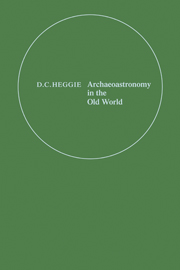Book contents
- Frontmatter
- Contents
- PREFACE
- LIST OF CONTRIBUTORS
- INVITED PAPERS
- MEGALITHIC ASTRONOMY: HIGHLIGHTS AND PROBLEMS
- ARCHAEOLOGY AND ASTRONOMY: AN ARCHAEOLOGICAL VIEW
- THE STATISTICAL APPROACH
- STATISTICAL AND PHILOSOPHICAL ARGUMENTS FOR THE ASTRONOMICAL SIGNIFICANCE OF STANDING STONES WITH A SECTION ON THE SOLAR CALENDAR
- MEGALITHIC ASTRONOMICAL SIGHTLINES: CURRENT REASSESSMENT AND FUTURE DIRECTIONS
- ASPECTS OF THE ARCHAEOASTRONOMY OF STONEHENGE
- IMPLICATIONS FOR ARCHAEOLOGY
- PI IN THE SKY
- CONTRIBUTED PAPERS
- INVITED PAPER
- INDEX
ASPECTS OF THE ARCHAEOASTRONOMY OF STONEHENGE
Published online by Cambridge University Press: 05 November 2011
- Frontmatter
- Contents
- PREFACE
- LIST OF CONTRIBUTORS
- INVITED PAPERS
- MEGALITHIC ASTRONOMY: HIGHLIGHTS AND PROBLEMS
- ARCHAEOLOGY AND ASTRONOMY: AN ARCHAEOLOGICAL VIEW
- THE STATISTICAL APPROACH
- STATISTICAL AND PHILOSOPHICAL ARGUMENTS FOR THE ASTRONOMICAL SIGNIFICANCE OF STANDING STONES WITH A SECTION ON THE SOLAR CALENDAR
- MEGALITHIC ASTRONOMICAL SIGHTLINES: CURRENT REASSESSMENT AND FUTURE DIRECTIONS
- ASPECTS OF THE ARCHAEOASTRONOMY OF STONEHENGE
- IMPLICATIONS FOR ARCHAEOLOGY
- PI IN THE SKY
- CONTRIBUTED PAPERS
- INVITED PAPER
- INDEX
Summary
Abstract. The building history of Stonehenge is outlined, and the principal astronomical hypotheses relating to each period of construction are critically examined. The conclusion is drawn that only the alignment of the Avenue on the summer solstice sunrise, established in period II at the end of the third millennium BC, can be accepted with confidence. All other interpretations are open to doubt or to alternative explanations. A note is appended on the possible equinoctial alignment of the West Kennet Long Barrow, dated to the mid-fourth millennium BC.
Stonehenge has a history of construction and use extending over more than two thousand years, from about 3100 BC to about 1000 BC or later, on the evidence of radiocarbon dates. As an aid to the understanding of the sequence of building, and of the possible astronomical alignments incorporated in each phase of construction, the principal components of each period are summarised below, with the relevant dates corrected according to R.M.Clark (1975), and are illustrated in figs. 1 and 2. A more detailed description can be found in Stonehenge (Atkinson 1979).
The earliest structures at Stonehenge are three pits found during the extension of the car park. Their excavators (Vatcher & Vatcher 1973) believed them to be postholes for massive tree-trunks, although their form and cross-section differ from those of other excavated postholes at Stonehenge. The late C.A. (‘Peter’) Newham suggested that they could have served as astronomical foresights (Newham 1972); but this must be discounted because pine charcoal from two of them has yielded radiocarbon dates of 7180 be ± 180 and 6140 be ± 140 (L.Vatcher, personal communication).
- Type
- Chapter
- Information
- Archaeoastronomy in the Old World , pp. 107 - 116Publisher: Cambridge University PressPrint publication year: 1982
- 1
- Cited by



